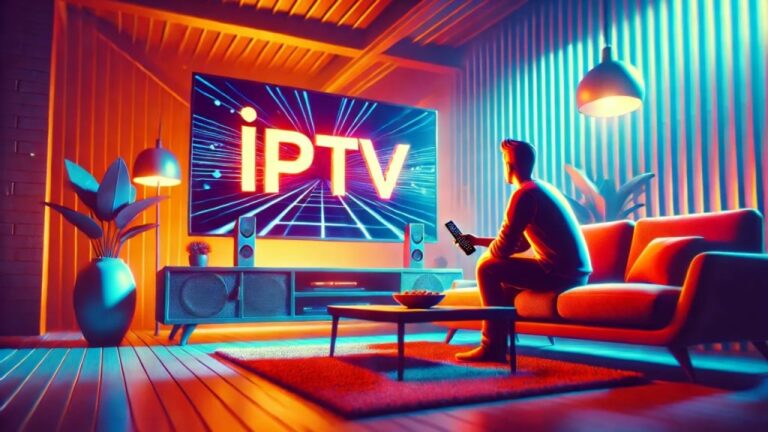Post Contents
The Future of 4K Live IPTV and Its Impact on Entertainment
In recent years, 4K Live IPTV has emerged as one of the most transformative technologies in the entertainment industry. With the rapid shift toward high-definition content, viewers are increasingly seeking richer, more immersive experiences that 4K streaming can provide. However, this is only the beginning. As technological advancements continue to evolve, 4K Live IPTV is poised to reshape how we consume media, what we watch, and even where we watch it.
In this article, we’ll explore the future of 4K Live IPTV, its potential innovations, the role of 5G technology, the emergence of new content formats, and the business strategies shaping its accessibility. Additionally, we’ll examine the environmental impact of streaming high-definition content and how providers and tech companies are addressing sustainability concerns. By looking ahead, we will uncover how 4K Live IPTV is not only enhancing entertainment experiences but also influencing the broader technological and social landscape.
The Evolution of 4K Live IPTV: A Glimpse into the Future
As we look toward the future, the evolution of 4K Live IPTV promises to bring a host of innovations that will redefine how we experience live television and streaming. Right now, 4K content is already a common offering for viewers who have compatible devices and internet speeds. However, several trends and technological shifts suggest that this is just the beginning. In the coming years, 4K Live IPTV will likely become more accessible, affordable, and versatile, offering even richer and more personalized experiences.

1. Wider Accessibility with Enhanced Bandwidth
One of the primary challenges of 4K Live IPTV today is the requirement for high-speed internet connections. 4K video files are significantly larger than HD content, and the bandwidth needed to stream them smoothly can strain existing infrastructure, especially in rural or underserved areas. However, as broadband networks expand and 5G technology continues to roll out, streaming high-quality 4K content will become more feasible for a larger number of consumers.
The widespread adoption of fiber-optic internet connections, paired with the roll-out of 5G networks, will significantly increase download and upload speeds. 5G, with its low latency and high throughput, is especially exciting for IPTV providers. It will enable near-instantaneous streaming of 4K content, even in congested network environments. This will allow IPTV services to reach a broader audience, particularly those in areas that have previously struggled with slow or unreliable internet connections.
2. The Integration of Artificial Intelligence and Personalization
As the demand for tailored content continues to rise, Artificial Intelligence (AI) will play an increasingly important role in the development of IPTV services. Imagine a world where your IPTV provider not only knows what you like to watch but also anticipates what you might enjoy next. AI algorithms will analyze viewing habits, personal preferences, and even contextual factors (such as time of day or mood) to offer ultra-personalized content recommendations.
This personalization goes beyond just suggesting movies or shows; it could involve adjusting video quality based on available bandwidth or providing interactive features that are specifically designed for you. For example, in sports broadcasting, AI could offer a multi-angle 4K stream where you, the viewer, choose the best camera angle based on your preferences. Over time, AI-driven content curation and delivery could become so sophisticated that it feels like your IPTV service is anticipating your every need.
3. Seamless Integration with Smart Home Ecosystems
As home automation systems and smart devices continue to proliferate, IPTV services will likely integrate more deeply with these ecosystems. Imagine being able to control your IPTV experience with your voice, or having your TV automatically switch to a 4K stream of a live event when your smart assistant recognizes that you’re home from work. Smart TVs, voice assistants, and other connected devices will create a more seamless entertainment experience, allowing you to effortlessly navigate your content.
Further innovations may include automatic adjustments to lighting, sound, and even room temperature, optimizing your environment for an immersive viewing experience. With smart TV interfaces that incorporate voice recognition and gesture controls, 4K Live IPTV could provide a more hands-on, intuitive way to interact with your content than ever before.
The Role of 5G in the Future of 4K Live IPTV
One of the most significant technological advancements on the horizon for 4K Live IPTV is the deployment of 5G networks. These ultra-fast, low-latency connections will offer immense benefits for streaming, especially in terms of improving the overall quality of service.
1. Reduced Latency and Faster Speeds
One of the key advantages of 5G over 4G is its significantly lower latency. For IPTV services, this means that streaming live events, such as sports or concerts, will be faster and more reliable. Viewers will be able to watch these events in real-time with little to no buffering, even in high-demand scenarios. This will greatly enhance the overall user experience, particularly for live broadcasts of high-energy events where delays are a major concern.
Additionally, the higher speeds offered by 5G networks will ensure that 4K content can be streamed with minimal interruptions. With 5G, even viewers in crowded public spaces—such as stadiums, airports, or shopping malls—will be able to access high-quality IPTV streams, something that is currently difficult with traditional broadband connections.
2. Mobile 4K Streaming
5G will also enable mobile devices to stream 4K content seamlessly. Today, streaming high-definition content on mobile devices is limited by the capacity of existing networks. But with 5G, mobile users can enjoy the same high-quality experience they would on a large home TV, all on the go. Whether watching live news broadcasts, sporting events, or concerts, the ability to stream in 4K will provide a richer and more immersive mobile entertainment experience.
For content providers, this opens up a new avenue for monetization. In the future, IPTV services could offer mobile-exclusive 4K content or bundled packages that allow users to switch seamlessly between mobile and home devices.
New Content Formats and Experiences: The Future of IPTV
As 4K Live IPTV evolves, we’re likely to see the emergence of entirely new types of content that take advantage of the technology’s capabilities. Some of the most exciting developments include:
1. Interactive Live Events
One of the most intriguing possibilities for the future of 4K Live IPTV is the rise of interactive live events. Imagine watching a sports game in 4K, where you can choose not only your camera angle but also interact with other viewers in real-time through a built-in chat or virtual environment. Fans could virtually “join” the event, interacting with the athletes, the host, or other viewers in real time.
This could extend beyond sports to other live events, such as concerts, theater performances, or even political debates. The ability to interact, ask questions, or vote on aspects of the event (like in reality TV) could transform the way audiences experience live content.

2. Virtual Reality (VR) and Augmented Reality (AR) Integration
As VR and AR technologies continue to mature, they could be incorporated into 4K Live IPTV services. Imagine watching a live concert where you can feel as if you’re sitting in the front row, or attending a sports event where you can virtually walk around the stadium. By wearing VR headsets or using AR-enabled devices, users could experience content in a fully immersive, 360-degree environment.
This kind of immersion could create entirely new types of live content, where viewers aren’t just passive observers but active participants. Whether it’s playing a game, participating in a virtual social event, or experiencing a live show, VR and AR will give users the opportunity to engage with their content in ways that were previously unimaginable.
Business Strategies: How IPTV Providers Are Adapting
As 4K Live IPTV becomes a mainstream service, providers are refining their business strategies to meet consumer demand for high-quality, on-demand content. This includes adapting pricing structures, content offerings, and delivery methods to make 4K content more accessible to a broader audience.
1. Subscription Models and Bundling
Many IPTV providers already offer subscription-based models, where consumers pay a monthly fee for access to live and on-demand content. As 4K content becomes more ubiquitous, we may see these subscription models evolve. Providers may introduce tiered pricing plans based on the type of content—offering 4K streams at a premium price while still making HD or SD content available at a lower rate.
Additionally, bundling 4K Live IPTV with other services—such as internet, mobile plans, or even smart home packages—could help drive adoption. For example, a telecom provider may offer a 4K IPTV subscription as part of a 5G mobile plan or a high-speed broadband service, making it more affordable and enticing for consumers.
2. Adoption of Hybrid and Over-the-Top (OTT) Services
Hybrid IPTV services that combine traditional broadcast with over-the-top (OTT) streaming platforms are becoming more common. As more content providers shift to direct-to-consumer models, hybrid IPTV services will allow users to access a broader array of 4K content—streaming from both traditional TV networks and OTT platforms like Netflix, Amazon Prime, and Disney+.
This convergence of content delivery methods will likely lead to more customizable and flexible viewing options. Consumers will be able to subscribe to an IPTV package that suits their interests—whether that’s sports, movies, or exclusive 4K content from OTT platforms—without being locked into rigid subscription models.
Business and Consumer Implications: Accessibility, Affordability, and the IPTV Landscape
As 4K Live IPTV continues to evolve, the business models and strategies employed by IPTV providers will have to adapt to meet the growing demand for high-quality, live-streamed content. Providers must strike a balance between affordability, accessibility, and innovation while also responding to consumer preferences. Here’s a look at some key trends shaping the future of 4K IPTV.
1. Greater Content Availability and Diversification
In the coming years, IPTV services are likely to offer an even wider range of content in 4K quality, expanding beyond traditional TV programming and movies. New genres of content such as live sports, immersive concerts, and interactive entertainment will continue to grow, attracting more subscribers. We can expect an increase in the availability of live-streamed events in 4K, including niche offerings that cater to specialized interests such as e-sports, virtual tourism, or international cultural festivals.
IPTV providers will also look to diversify their content partnerships. Collaboration with major OTT platforms like Netflix, Disney+ could become more common, allowing users to access a broader array of 4K content under a single subscription. This type of partnership could provide a significant value proposition for consumers, especially when bundled with other services such as mobile or broadband.
2. Flexible Pricing and Subscription Models
To make 4K Live IPTV more accessible to a broader audience, many providers will likely continue to experiment with flexible pricing and subscription models. In particular, there may be a greater emphasis on offering tiered pricing, allowing consumers to pay for 4K content on-demand or through add-on packages. For instance, a consumer might subscribe to a standard IPTV package with HD content and pay a small premium for select 4K streams of live sports or blockbuster movies.
Additionally, providers may offer ad-supported models, where users can access certain 4K content for free in exchange for watching ads. This will open up IPTV services to budget-conscious consumers who might otherwise be unable to afford premium subscriptions. On the other hand, more affluent consumers may opt for ad-free packages that deliver the best 4K content with additional features, such as exclusive shows, early releases, or interactive capabilities.
3. Greater Focus on Customer Experience
With competition among IPTV providers intensifying, customer experience will become a key differentiator. Providers will look to enhance the user interface (UI) and user experience (UX) of their platforms, offering intuitive navigation, fast load times, and smooth transitions between content types. Personalized recommendations based on viewing history, seamless content switching between 4K and HD, and AI-powered interaction will all be part of this enhanced experience.
Additionally, as consumers increasingly expect instant access to content, IPTV platforms will need to ensure that streaming is fast and uninterrupted. As 5G networks expand and smart devices become more capable, users will expect a seamless transition between devices—allowing them to start watching content on a smart TV and finish it on their mobile phone, all in 4K resolution.











